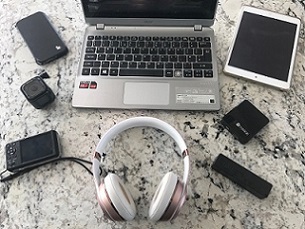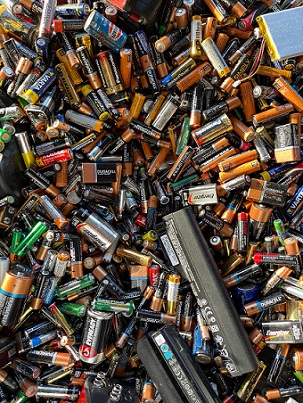 Just some of the gadgets taken onto planes that are powered by lithium-ion batteries
Just some of the gadgets taken onto planes that are powered by lithium-ion batteries
 An AvSax battery fire mitigation bag, also known as a burn bag
An AvSax battery fire mitigation bag, also known as a burn bag
 Lithium-ion batteries come in all shapes and sizes
Lithium-ion batteries come in all shapes and sizes
 The confined space within an aircraft passenger cabin is the last place you’d want a lithium-ion battery fire to start
The confined space within an aircraft passenger cabin is the last place you’d want a lithium-ion battery fire to start
One of the world’s biggest aircraft manufacturers says traditional firefighting methods won’t extinguish a lithium battery fire on board an aircraft.
Lithium-ion batteries are used to power almost every personal electronic device we use these days from mobile phones to laptops so colossal amounts of them are taken on board aircraft every year and some do catch fire which can potentially have catastrophic consequences.
A report by Airbus called Lithium batteries, safe to fly? about the dangers states: “Hundreds of millions of lithium batteries or equipment with lithium batteries are carried on aircraft annually.
“But the introduction of lithium batteries included some highly visible cases of mobile phones or laptops self-igniting and burning. Likewise, several events have occurred on aircraft, ranging from localised and limited fires to large, uncontrolled in-flight fires resulting in hull losses and fatalities.”
Once lithium batteries overheat they can quickly go into what’s known as thermal runaway, a rapid, uncontrolled chemical reaction within the battery that causes the internal temperature to rise.
When one cell in a battery overheats it can produce enough heat - up to 900°C (1652°F) - to make adjacent cells overheat too. This can cause a lithium battery fire to flare repeatedly which is why many airlines use award-winning AvSax fire and smoke mitigation bags that use liquid inside them to keep the overheating battery cool. AvSax are also known as ‘burn bags’.
In the USA alone, the Federal Aviation Administration reports that up to June 30, 2021, there have been 322 thermal incidents involving lithium batteries as air cargo or baggage recorded since January 23, 2006. Many of the batteries were in personal electronic devices (PEDS) such as headphones, mobile phones, laptops and even e-cigarettes.
The Airbus report states: “Classical firefighting procedures and fire extinguishing are not efficient to stop a lithium battery fire.
“Halon can suppress open flames but it’s ineffective in addressing the source of fire. Use of water is the best option to allow cooling and limit the propagation to adjacent cells.
“Once a lithium battery cell has ignited then the effort must concentrate on cooling the surrounding cells by use of water (or other non-alcoholic liquid) and preventing deterioration of the situation to avoid any fire propagation to the adjacent battery cells.”
AvSax battery fire mitigation bags do have this vital cooling aspect built into the effective way they work to contain overheating lithium-ion batteries.
The report adds: “Federal Aviation Administration tests show that even a small number of overheating batteries emit gases that can cause explosions and fires that cannot be prevented by traditional fire suppression systems. In view of the possible consequences, lithium batteries are classified as hazardous materials so particular care and consideration must be taken to ensure safe operations in relation to use and transport of lithium batteries (or devices containing lithium batteries) when in an aircraft environment.”
Airbus also says all personal electronic items and spare batteries must be taken into the passenger compartment and never put in the hold as the automatic fire suppression systems in there can’t cope with a lithium battery fire.
The report warns: “Lithium-ion batteries themselves represent a significant threat due to the fact that the existing cargo compartment fire suppression functions are ineffective against a lithium-ion battery fire.”
And it’s even more potentially dangerous if a plane is carrying a cargo of lithium batteries.
The report adds: “Irrespective of the size of the shipment, research into the impact of both lithium-metal and lithium-ion batteries fire has demonstrated that the existing cargo compartment fire suppression systems – namely Halon 1301 or oxygen starvation – are unable to stop a thermal runaway and prevent propagation to adjacent cells. If a thermal runaway is initiated, heat and flammable gases coming from the degradation of the hydrocarbon electrolyte will be emitted.
“The existing fire protection cargo systems are not capable of containing these accumulated gases.
“The passive protection standards are designed to withstand heat sources for up to five minutes and are not resistant against the characteristics of a lithium battery fire. The temperature, duration and intensity of such a fire will quickly overwhelm the passive protections.”
AvSax are the world’s best-selling fire containment bag for PEDs on aircraft and are now on more than 15,373 aircraft operated by 80 airline companies. They have been used 33 times to deal with emergencies since the start of 2017 and every time they have been deployed the aircraft has been able to complete its journey safely with no need to divert or make an emergency landing.
AvSax won the prestigious Queen’s Award for Enterprise in the UK in 2018.
To see the full Airbus report got to https://safetyfirst.airbus.com/lithium-batteries-safe-to-fly/